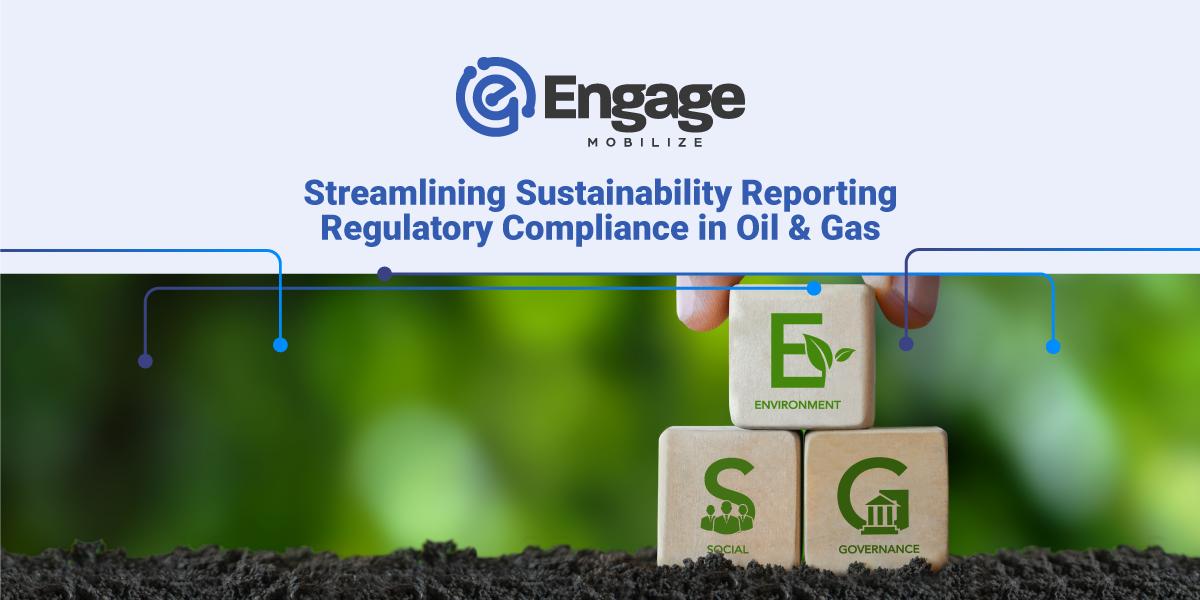Streamlining Emissions and Regulatory Reporting with Technology

Streamlining Sustainability Reporting and Regulatory Compliance in the Oil and Gas Industry
The oil and gas industry plays a pivotal role in meeting the world's affordable and reliable energy needs. However, it also faces increasing scrutiny due to its environmental impact. Sustainability reporting, particularly regarding emissions and regulatory compliance, has become an essential reporting function for oil and gas operators, as the information is used by investors, regulators and other key stakeholders.
In this article, we explore the significance of sustainability reports in the oil and gas industry, the complexities of emissions reporting, common challenges operators face, and how Engage Mobilize's intelligent field operations software is transforming the sustainability reporting process.
The Importance of Sustainability Reports in the Oil and Gas Industry
Sustainability reports are critical for oil and gas operators as they provide a transparent view of their environmental performance. These reports typically have a key focus on Scope 1, Scope 2, and Scope 3 emissions, offering a comprehensive overview of an operator's carbon footprint and its impact on the environment.
Ipieca has emerged as an essential resource for oil and gas operators. Collaborating with the American Petroleum Institute (API) and the International Association of Oil & Gas Producers (IOGP) has published guidelines for industry sustainability reports. Ipieca members include leading operators including ExxonMobil, HESS, Oxy, BP, Chevron, Halliburton, Marathon Oil, EOG Resources and many more.
Focus on Scope 1, Scope 2, and Scope 3 Emissions
The U.S. Environmental Protection Agency (EPA) has defined three primary types of emissions by source, briefly described below.
Scope 1: These emissions originate from sources directly owned or controlled by a company, such as generators fueled with diesel or natural gas, compressors, flare stacks, pneumatic devices, control valves, tank batteries, etc.
Scope 2: These emissions are indirect, arising from the production of energy purchased and used by the company. For instance, emissions associated with electricity purchased from the grid fall into this category.
Scope 3: These emissions extend up and down the value chain and are not directly controlled by the company. Examples include emissions from fuel trucks delivering fuel to company operations.
Operators typically have the most control over Scope 1 emissions, making tracking and managing them effectively essential.
The graphic below illustrates common emission source types based on where the reporting company sits in the value chain (source: EPA).

5 Common Issues in Sustainability Reporting
Several challenges can hinder effective emissions and regulatory reporting for oil and gas operators and make the task difficult:
- Data Gathering: Operators must gather data from various sources, making data collection labor-intensive and prone to errors.
- Time-Consuming: Sustainability reporting can be time-consuming, diverting resources from core operations.
- Low-Quality Data: Inaccurate or incomplete data can compromise the reliability of reports.
- Lack of Actionability: Data overload and an inability to translate it into actionable insights hinder decision-making.
- Complexity: Understanding and making sense of emissions data, particularly Scope 3, can be complex.
How Engage Mobilize Streamlines Emissions Reporting
Engage Mobilize offers a comprehensive solution for emissions reporting in the oil and gas industry.
Here's how. The Engage Mobilize mobile app uses GPS to track actual miles driven by service units and crews at the individual and company levels, providing a precise baseline for calculating Scope 3 emissions related to activities like fluids hauling, crude oil hauling, roustabout services and chemical deliveries.
The mileage data can be easily downloaded and used to calculate the total miles driven for each service provider. Applying an emissions factor to the miles-driven data produces a reliable estimate of Scope 3 emissions.
Petrolegacy's success story showcases how Engage Mobilize simplifies ESG reporting by automatically capturing Scope 3 emissions data.
How Engage Mobilize Simplifies Regulatory Reporting
Apart from emissions reporting, Engage Mobilize also simplifies regulatory compliance:
- Lone Worker Regulations (stranded workers): The software ensures compliance with OSHA 1915.84 for lone workers in the field, enabling seamless communication with individuals working alone to ensure they are not stranded.
- Restricted Road Reporting: Engage Mobilize's breadcrumbing feature identifies instances when vehicles enter restricted areas or use restricted roads.
- Vendor Tracking: Automated vendor tracking simplifies monitoring and reporting while service companies perform work for the operator.
- Electronic Inspections: The software facilitates compliance with regulatory requirements through electronic inspection and regulatory forms.
Summary
Creating sustainability reports in the oil and gas industry can be daunting, given the complexities of emissions and regulatory compliance. Engage Mobilize's intelligent field operations software offers a streamlined solution to address these challenges, providing accurate emissions tracking and simplifying regulatory reporting.
Contact us today at (720) 575-6695 or Sales@engage-m.com to learn how Intelligent Field Automation Software from Engage Mobilize can help you simplify the sustainability reporting process with more accurate data.
Are you ready to learn more?
We’re ready to talk to you about the specific cost savings, workflow efficiencies and data insights that come from taking your field operations digital.
Share this
Similar Stories

Optimizing Crude Oil Revenue with the Engage Mobilize Gravity Balancing Report

Enhance Field Service with Engage Mobilize: GPS-Boosted Transparency & Efficiency


.png?width=2087&height=449&name=ESG%20Blog%20Banner%20%20(1).png)
